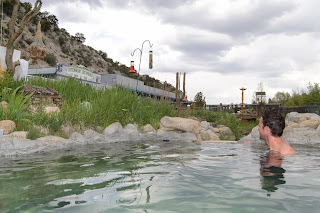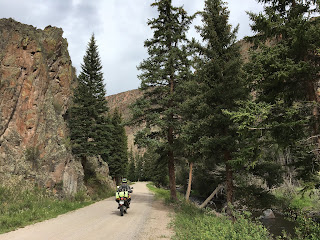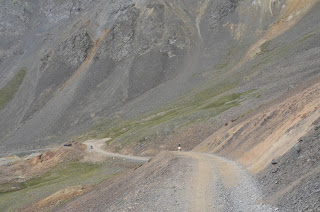Leaving Buena Vista, Colorado, our intended route was to head up to Cottonwood Pass where we'd regain the Colorado BDR on the crest of the Divide and follow it south. But we discovered the road was closed throughout 2018 to allow for a major renovation of the pavement. Too bad, because one of my personal goals for the trip was to soak in the Cottonwood hot springs near the start of the ascent, which I'd last visited with a friend on a mountain biking trip back in 2007:
However, the other guys weren't keen on the hot springs, and since we had to find another route, it was out of our way. While I was a little bummed by this, there was still lots to discover and the hardest parts of our trip (with all their uncertainties and how they'd affect our schedule) still lay before us. Tincup Pass just to the south looked like a convenient alternative route back to the BDR, although we'd heard it was one of the more technical options and could be a significant challenge on loaded ADV bikes. Despite some trepidation from the other guys (see, that's where pre-relaxation in a hot spring can help!), we were all pretty excited to give it a shot.
The approach to Tincup up Chalk Creek gulch passed by Mt. Princeton and the aptly named Silver Cliffs, which were brilliantly illuminated by morning sun.
Eventually we reached the historic mining town of St. Elmo.
While there didn't seem to be much open to visitors when we passed through, the town now serves as a major jumping-off point for OHV tours and was buzzing with squadrons of Jeeps, side-by-sides, and the occasional dirt bike arriving and lining up for departure. We were the only ADV riders in sight. Had there been no crowd, we might've looked around a bit. Instead, we decided to head straight for the top to avoid worsening congestion.
Since the road over the pass is designated a county road, you don't need an OHV permit to travel it so as long as you stay on the main track. But don't be fooled by the county road status: this pass proved to be one of the most technical sections of the whole trip. Jeff had already worked up some serious anxiety after watching a number of Jeep videos the night before, whereas Pete was his usual cheerful British understated self, Buddha-like in his philosophical reaction to danger.
It was indeed hard work, and I wasn't able to grab photos of the ascent since there was no good opportunity to stop. Be assured the track was narrow, steep, lined with dense bush, covered in loose softball- and head-sized boulders, washed-out, rutted, and overrun with OHV traffic that couldn't travel very fast and raised choking dust. Couple with the elevation gain, both my and my bike's engine struggled to breathe and stay cool.
Maintaining forward momentum was key to staying upright, so a lot of my riding was in gears 1-3 to handle the grade and not stall out. Too slow, and the suspension would just follow the bumps instead of compressing, causing you to get stuck. Too fast, and you'd jackhammer the obstacles too hard, get air, and lose control. You had to trust that your bike would work and use the gas. The magic speed for me was about 2-3 times as fast as the OHVs, so I was able to fly past them on the few occasions where there was room, and when we could see each other through the clouds of dust. There were few places to stop in the forest on the way up, so each of us picked our own way on our own time, using our helmet comms to call out obstacles and strategies and novel curses.
Had the trail been wet or muddy, it might very well have been too hard for us to ride with our loads. There was lots of evidence of prior mud and deep puddles, but amazingly it was mostly dry for us and therefore reasonably grippy.
We arrived at the pass (12,154') all sweaty and pumped out, glad to have the traffic jams behind us.
The descent proved harder: first, a greasy series of rock steps among loose stones. I went first to recon a line, and then together we coaxed and spotted each other through, each taking different lines with a couple of dropped bikes along the way. It would've been significantly easier without our loads, which added unwanted inertia to delicate maneuvers and sapped throttle response--especially at the high elevation.
The steps were followed by a white-knuckle ski-ride down a relentless grade with a ball-bearing surface. Braking was all but useless with our loaded bikes, so again we had to find a speed that was fast enough to let the suspension do its thing, but not so fast that you'd run away and hit something too hard--which included significant traffic coming uphill towards us. It took all our concentration to ride, because often the best line was blocked by an oncoming Jeep or ATV and you'd find yourself bouncing through the worst of the loose stuff. Most of this section would've been a real challenge on a big ADV bike and I wouldn't recommend it unless you've got long legs (or a low seat), have full knobbies, and are very comfortable riding technical trails.
Today there's little to see in the historic mining community of Tincup, although it's a popular stop for OHVers and there's a small seasonal population.
Tincup put us back on the Colorado BDR, so we continued south along the crest of a range with wide vistas in all directions. This view is looking towards the north, where in the distance we would've reached the same road via Cottonwood Pass.
Few vehicles, and no services. You're pretty much on your own in these parts. Didn't see any other motorbikes. The whole area is dotted with the countless remains of old mines and ghost towns.
More desolate dirt road led us through Pitkin, Cumberland Pass, and Wuanita Pass, descending from the sharp peaks through forrest and into high plains terrain. We began to see a few ADV riders passing us on their way north, but remarkably few other signs of civilization as the forest gave way to open ranch land. As we descended, it got hot and windy--typical in the mountains as the sun's energy builds into afternoon storms.
At a stop along the way we discovered that Pete had lost his RotoPax. The hardware had vibrated loose, and both the can and entire mount had managed to slip out from under his strapped-on top bag and ended up as valuable trail booty for someone else. After reviewing photos, we figured it probably happened somewhere on Tincup Pass, and simply wasn't obvious because his bag normally obscured the RotoPax anyway. Nevertheless, we were now in a remote area and Pete was short of fuel. We decided to deviate from our route to nearby Gunnison for grub and gas. Last time I was here in 2007 it was pouring rain and deserted, and I didn't get to ride the local trails. Now the town seemed much more bustling, and downtown we found a good brew pub with friendly staff.
With storms threatening and Jeff particularly worn out from the day's technical riding, we left Gunnison to pick up the BDR again and look for camping. The entire area was open range with no easily accessible forest, so we were concerned about finding a spot where we wouldn't be exposed to either storms or gun-toting ranchers. Miraculously--and almost at our wits end for the day, a recon down a dirt track revealed a hidden reservoir with campsites, an outhouse, and a lot of 9mm brass scattered around. A dodgy trickle of water leading into the reservoir proved barely adequate for cooking. The natural bowl of the site provided both shelter from the wind and amplified acoustics, allowing the smallest squeak from birds or beasts to be amplified somewhat alarmingly in the middle of the night, when we heard splashing in the little stream beside our tents.
Nothing like a little Bourbon to take the edge off! Should've gotten more of this.
None of us had a great sleep that night. The next morning, and low on water, we ate handfuls of trail mix and pushed on towards the highest passes of the trip. By this stage we were each pretty much lost in our own thoughts, isolated in our helmets somewhat by the unreliable and garbled communications of our Senas, which were often drowned our by noise from the relentless wind tearing across the open range.
Soon the dry, almost desert-like country rose into the fragrant forests of Los Pinos Pass. The dirt track descended into canyons and the emerging San Juan Range.
Ahead lay the highest passes of the trip, but first we needed to cross an extraordinary geological feature.
According to the sign at a visitor's pullout:
About 850 years ago, thousands of tons of water-saturated, earthen material broke away from Mesa Seco and slid nearly four miles into the valley below. The Slumgullion Earthflow dammed the Lake Fork of the Gunnison River and formed Lake San Cristobal - the second largest natural lake in Colorado.
About 350 years ago, another portion of Mesa Seco began to slowly ooze down the hillside. Riding above the older slide, this flow covered about 2.5 miles of the older flow. Geologists estimate that it is still moving downhill approximately twenty feet per year.There were many signs of the slide, including large stands of trees tilted at an unnatural downhill angle. A freshly paved highway carved down through the slide, affording some fun cornering after days on slippery dirt.
The frontier town of Lake City made a good brunch stop with free wifi, and there's a good general store with freeze-dried food, nuts, jerky and other ADV essentials. Some interesting old stone buildings in town and again, platoons of ATVs all lining up for day trips over the high passes next on our own agenda. The police were in full action pulling over speeders in ATVs, so it's important to ride carefully here.
Replenished and full of eggs and sausage, we followed the traffic towards Cinnamon Pass. While nowhere near as technical as Tincup Pass, at 12,640' it was one of the highest on our trip and it followed a steep route that required your attention--not least because of all the other trail users and the effects of elevation. The scenery was literally breathtaking, and I could ride this over and over again.
Although it was a struggle for our 250s, we made it over the pass and dropped down into the mining ghost town of Animas Forks at 11,200'. A National Historic site, it's famous today for the remarkable state of preservation of its buildings, which you can walk through. The site receives more than 100,000 visitors per year, and we could believe that given the steady stream of Jeeps and side-by-sides crawling up and down the mountain roads to this location.
Here's what the town looked like circa 1906. Incredibly, there was once a railway to this location:
And today, from a similar vantage point of one of the former mine sites. The road to the right leads up to Engineers Pass, another extraordinary feat of willpower over nature. This pass remains on my bucket list but it's more technical than most and probably requires an OHV permit and more horsepower than my 250 can muster.
The two-story building with the bay window on the right of the above photo is the William Duncan House, built in 1879. Here's a view from inside:
At a home next door was this indoor latrine, below. One winter, the town received 25 feet of snow and residents had to tunnel between buildings. Having indoor "plumbing" would've been a necessity compared to an outhouse. I recall distinctly the outhouses I lived with as a boy in Australia, and certainly wouldn't want to have to trudge out to one in the dead of winter at these elevations.
Met a guy rock-picking a tailings pile, and he showed me this excellent sample of silver ore-bearing rock.
By now the afternoon storms were rumbling in, and we were concerned about getting caught on an exposed ridge where lightning strikes could pose a very real risk. We opted to get down to lower ground quickly, and decide next steps based on what the weather did.
Not far south of Animas Forks is the ghost town of Eureka. While we didn't pass through there on our trip, I recently on a a Reddit thread the following photo from 1900 that's been expertly colorized by Sanna Dullaway. It really helps show the historic appearance of the region.
The same view today, at the same location, can be seen here on Google Street view (photograph by Seth Thomas).
With the storms seeming to head in the opposite direction, we decided to make a sprint for California Pass, the highest of the trip at 12,960'.
Part 11


































No comments:
Post a Comment